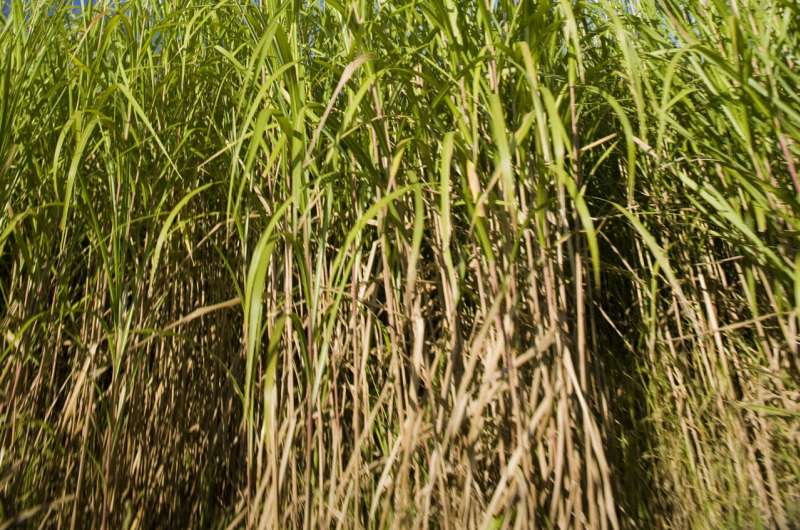Study finds that the genetic makeup of host plants influences the microorganisms they attract

December 19, 2023
The credibility of this article has been carefully assessed, in accordance with the editorial process and policies of Science X. During the review, editors have specifically focused on the following aspects:
- confirmation of facts
- verified through a peer-reviewed publication
- dependable source
- meticulously proofread
by Ananya Sen, University of Illinois at Urbana-Champaign
In the plant world, they often create communities with microorganisms in their roots, which sway the plant's health and growth. While the absorption of these microbes is governed by multiple factors, the host plant's genetic variation's role has not been clearly defined. Scientists from the University of Illinois Urbana-Champaign conducted a novel study on this subject, which could potentially boost agricultural productivity.
Professor Angela Kent (CABBI), from the University's Department of Natural Resources and Environmental Sciences commented, 'Researchers, in the past, have merely scrutinized the type of microbes present in plant associations, but haven't delved into the factors shaping these communities, and the possibility of us influencing these factors via plant breeding.'
Microbes form intricate microbiome networks in and around a plant's roots. Chemical signals emitted by host plants can selectively allow certain microbes or endophytes into their root network and can adjust the soil attributes surrounding the roots to control which microbes grow on the root surface known as the rhizosphere.
Nonetheless, before creating plant breeds based on their microbe associations, it is crucial for researchers to comprehend to what degree the plant genomes can regulate the rhizosphere's microbiome.
The team of researchers directed their study on two types of native silver grass– Miscanthus sinensis and Miscanthus floridulus. Labelled as potential candidates for bioenergy crops, these plants call for lesser nutrient concentrations for greater growth in comparison to conventional crops.
The researchers held their study amidst 16 locations across Taiwan, spanning a variety of environmental conditions, such as hot springs, mountain tops, and valleys. They picked a total of 236 rhizosphere soil samples from randomly chosen Miscanthus plants, additionally isolating the root's microbiome.
'Despite the extensive scope of our analysis, we made sure to comply with the plant protection and quarantine norms. We processed the samples in Taiwan to extract the endophytic microbial community and gather the rhizosphere microbiome,' said Kent.
The researchers employed two distinct DNA sequencing methods in their research. The microbiomes within and around plant roots were identified using the DNA sequence of bacterial and fungal rRNA genes. Variations in the plant genome were observed using microsatellites, which are repeating DNA sequences that can differentiate between closely related plant populations.
Kent shared, 'These samples were gathered 15 years ago when the project was too large for the sequencing capabilities at that point. As sequencing became cheaper over the years, we were able to reanalyze the data and take a closer look at the microbiome. We unintentionally extracted plant DNA during the sample processing, which we utilized for genotyping our Miscanthus populations.'
Postdoctoral researcher Niuniu Ji, working in the Kent lab, added, 'I studied the host genome sequences to gain knowledge about how they could impact the microbiome. Discovering that plants affect the microbiome was an exciting find.'
Despite the rich diversity present in plant microbiomes, the concept of the 'core microbiome' refers to the group of microorganisms commonly found in most samples from a specific plant set. These microbes are deemed essential in determining which other microbes associate with the host plant and in promoting its growth.
Interestingly, the research team discovered nitrogen-fixing bacteria, which have been observed in other studies pertaining to rice and barley, in the core microbiome of Miscanthus. These microbes are integral for plant growth as they help with the acquisition of nitrogen. Recruiting nitrogen-fixing microbes may not only enable plants to adapt to various environments, but importantly, it also provides a sustainability factor for this grass potential as a bioenergy crop.
Meanwhile, the genetic variations amongst the plants had a lesser impact on the rhizosphere microbiome, primarily affected more by soil environment. Nevertheless, the plants showed a tendency to invite more fungi compared to other microbes.
The researchers are interested in parsing out which genes play a role in influencing the microbiome. 'The microsatellites do not have a biological function and are not representative of the whole genome. It would be nice if we could sequence the whole Miscanthus genome and figure out how the genes affect nitrogen fixation,' Ji said.
'Crop breeding is based on yield. However, we need to take a wider look and consider how microbes can contribute to crop sustainability,' Kent said. 'The appeal of working with wild plants is that there is vast genetic variation to look at. We can identify which variants are good at recruiting nitrogen-fixing microbes because we can use fewer fertilizers on these crops. It's an exciting possibility as we embark on adapting these plants for bioenergy purposes.'
The study 'Host genetic variation drives the differentiation in the ecological role of the native Miscanthus root-associated microbiome' was published in Microbiome.
Journal information: Microbiome
Provided by University of Illinois at Urbana-Champaign




